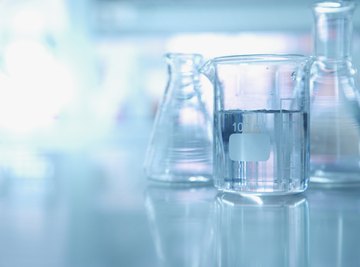
If someone asked you to define "liquid," you might start with your everyday experience with things you know that qualify as liquids and attempt to generalize from there. Water, of course, is the most important and ubiquitous liquid on Earth; one thing that sets it apart is that it has no definite shape, instead conforming to the shape of whatever contains it, be this a thimble or a massive depression in the planet. You probably associate "liquid" with "flowing," such as a river current, or melted ice running down the side of a rock.
This "You know a liquid when you see one" idea, however, has its limits. Water is clearly a liquid, as is soda. But what about a milkshake, which spreads out over any surface it is poured on, but more slowly than water or soda. And if a milkshake is a liquid, then how about ice cream that is just about to melt? Or ice cream itself? As it happens, physicists have helpfully produced formal definitions of a liquid, along with the other two states of matter.
What Are the Different States of Matter?
Matter can exist in one of three states: As a solid, a liquid or a gas. You may see people using "liquid" and "fluid" interchangeably in everyday language, such as, "Drink plenty of fluids when you exercise in hot weather" and "It's important to consume a lot of liquids when running a marathon." But formally, the liquid state of matter and the gas state of matter together make up fluids. A fluid is anything that lacks the ability to resist deformation. Although not all fluids are liquids, the physical equations governing fluids apply universally to liquids as well as to gases. Therefore, any mathematical problem you are asked to solve that involves liquids can be worked out by using the equations governing fluid dynamics and kinetics.
Solids, liquids and gases are made of microscopic particles, with the behavior of each determining the resultant state of matter. In a solid, particles are tightly packed, usually in a regular pattern; these particles vibrate, or "jiggle," but do not in general move from place to place. In a gas, particles are well-separated and have no regular arrangement; they vibrate and move about freely at considerable speeds. Particles in a liquid are close together, although not as tightly packed as in solids. These particles have no regular arrangement and resemble gases rather than solids in this respect. The particles vibrate, move about and slide past each other.
Both gases and liquids assume the shape of whatever containers they occupy, a property solids do not have. Gases, because they normally have so much room between particles, are easily compressed by mechanical forces. Liquids are not easily compressed, and solids are still less easily compressed. Both gases and liquids, which as noted above are together called fluids, flow easily; solids do not.
What Are the Properties of Fluids?
First, fluids have kinematic properties, or properties related to fluid motion, such as velocity and acceleration. Solids of course have such properties as well, but the equations used to describe them are different. Second, fluids have thermodynamic properties, which describe the thermodynamic state of a fluid. These include:
- temperature
- pressure
- density
- internal energy
- specific entropy
- specific enthalpy
- others
Only a few of these will be detailed here. Finally, fluids have a number of miscellaneous properties that do not fall into either of the other two categories (e.g., viscosity, a measure of a fluid's friction; surface tension; and vapor pressure).
What Are Different Types of Fluids?
The two fluids of major interest in the real world are water and air. Common types of liquids in addition to water include oil, gasoline, kerosene, solvents and beverages. Many of the more commonly encountered liquids, including fuels and solvents, are poisonous, flammable or otherwise dangerous, making them hazardous to have in the home because if children get hold of them, they may confuse them with potable liquids and consume them, leading to dire health emergencies.
The human body, and in fact almost all life, is predominantly water. Blood is not considered a liquid, because the solids in blood are not evenly dispersed throughout or fully dissolved in it. Instead, it is considered a suspension. The plasma component of blood can be regarded as a liquid for most purposes. Regardless, fluid maintenance is vital to everyday life. In most situations, people do not think about how critical potable liquids are to survival, because in the modern world it is rare to not have ready access to clean water. But people routinely get into physical trouble as a result of excessive fluid losses during sports competitions such as marathons, football games and triathlons, even though some of these events include literally dozens of aid stations offering water, sports drinks and energy gels (which might be considered liquids). It is a curiosity of evolution that so many people manage to get dehydrated even while usually knowing how much they must drink in order to attain top performance or at least avoid winding up in the medical tent.
Fluid Flow
Some of the physics of fluids have been described, probably enough to allow you to hold your own in a basic scientific conversation about liquid properties. However, it is in the area of fluid flow where things become especially interesting.
Fluid mechanics is the branch of physics that studies the dynamic properties of fluids. In this section, because of the importance of air and other gases in aeronautics and other engineering fields, "fluid" may refer to either a liquid or a gas – any substance that changes shape uniformly in response to external forces. The motion of fluids can be characterized by differential equations, which stem from calculus. The movement of fluids, like the movement of solids, transfers mass, momentum (mass times velocity) and energy (force multiplied by distance) in the flow. In addition, the motion of fluids can be described by conservation equations, such as the Navier-Stokes equations.
One way in which fluids move that solids do not is that they exhibit shearing. This is a consequence of the readiness with which fluids can be deformed. Shearing refers to differential movements within a body of fluid as a result of the application of asymmetrical forces. An example is a channel of water, which exhibits eddies and other localized movements even as the water as a whole moves through the channel at a fixed rate in terms of volume per unit time. The shear stress τ (the Greek letter tau) of a fluid is equal to the velocity gradient (du/dy) multiplied by the dynamic viscosity μ; that is, τ = μ(du/dy).
Other concepts related to fluid movements include drag and lift, both of which are crucial in aeronautical engineering. Drag is a resistive force that comes in two forms: Surface drag, which acts on just the surface of a body moving through water (e.g., the skin of a swimmer), and form drag, which has to do with the overall shape of the body moving through the fluid. This force is written:
FD = CDρA(v2/2)
Where C is a constant that depends on the nature of the object experiencing drag, ρ is density, A is cross-sectional area and v is velocity. Similarly, lift, which is a net force that acts perpendicular to the direction of the motion of a fluid, is described by the expression:
FL = CLρA(v2/2)
Fluids in Human Physiology
About 60 percent of the total weight of your body consists of water. Roughly two-thirds of this, or 40 percent of your total weight, is inside cells, while the other third, or 20 percent of your weight, is in what is called the extracellular space. The water component of blood is in this extracellular space, and accounts for about one-fourth of all extracellular water, i.e., 5 percent of the body's total. Since about 60 percent of your blood actually consists of plasma while the other 40 percent is solids (e.g., red blood cells), you can calculate about how much blood you have in your body based on your weight.
A 70-kg (154-pound) person has about (0.60)(70) = 42 kg of water in her body. One-third would be extracellular fluid, about 14 kg. A fourth of this would be blood plasma – 3.5 kg. This means that the total amount of blood in this person's body weighs about (3.5 kg/0.6) = 5.8 kg.
References
About the Author
Kevin Beck holds a bachelor's degree in physics with minors in math and chemistry from the University of Vermont. Formerly with ScienceBlogs.com and the editor of "Run Strong," he has written for Runner's World, Men's Fitness, Competitor, and a variety of other publications. More about Kevin and links to his professional work can be found at www.kemibe.com.
